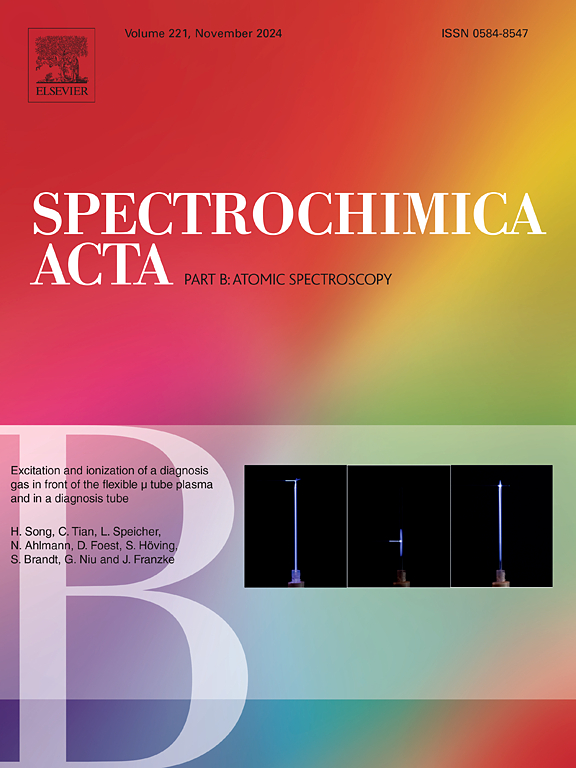Analysis of impurities in NaPF6 for sodium-ion batteries by inductively coupled plasma tandem mass spectrometry
IF 3.8
2区 化学
Q1 SPECTROSCOPY
引用次数: 0
Abstract
To detect metal impurities in the electrolyte of sodium-ion batteries (sodium hexafluorophosphate, NaPF6) and ensure the performance stability and safety of sodium-ion batteries, a new strategy for identifying detrimental metal impurities is proposed. In this work, inductively coupled plasma tandem mass spectrometry (ICP-MS/MS) was used to study 12 metal impurities in NaPF6. The NaPF6 sample was dissolved in ultra-pure water and directly analyzed by ICP-MS/MS, and the spectral interference was eliminated by the reaction gas mixture N2O/H2 in the MS/MS mode. The analysis results were compared with the results from sector field (SF)-ICP-MS, and the accuracy and reliability of the developed method were evaluated by a spike recovery test. Under optimized conditions, the limit of detection (LOD) of analytes was in the range of 0.16–3.2 ng L−1, the spiked recovery was in the range of 94.4 %–105 %, and the relative standard deviation (RSD) was 1.3 %–4.1 %. Statistical analysis showed that, at the confidence level of 95 %, there was no significant difference between the analysis results from the developed method and SF-ICP-MS. The developed method is accurate and reliable, with good stability and high accuracy. The ICP-MS/MS method based on the N2O/H2 reaction mode shows strong potential for analyzing various metal impurities in NaPF6, and can be extended to other fields with great reference value.

电感耦合等离子体串联质谱法分析钠离子电池用NaPF6杂质
为了检测钠离子电池电解液(六氟磷酸钠,NaPF6)中的金属杂质,确保钠离子电池性能的稳定性和安全性,提出了一种新的有害金属杂质识别策略。本文采用电感耦合等离子体串联质谱(ICP-MS/MS)对NaPF6中的12种金属杂质进行了研究。将样品溶解于超纯水中,采用ICP-MS/MS直接分析,反应气体N2O/H2在MS/MS模式下消除了光谱干扰。将分析结果与扇形场(SF)-ICP-MS分析结果进行比较,并通过峰回收率试验评价所建立方法的准确性和可靠性。优化条件下,分析物的检出限为0.16 ~ 3.2 ng L−1,加标回收率为94.4% ~ 105%,相对标准偏差(RSD)为1.3% ~ 4.1%。统计分析表明,在95%的置信水平下,该方法的分析结果与SF-ICP-MS的分析结果无显著差异。该方法准确可靠,稳定性好,准确度高。基于N2O/H2反应模式的ICP-MS/MS方法在分析NaPF6中各种金属杂质方面具有很强的潜力,可以推广到其他领域,具有重要的参考价值。
本文章由计算机程序翻译,如有差异,请以英文原文为准。
求助全文
约1分钟内获得全文
求助全文
来源期刊
CiteScore
6.10
自引率
12.10%
发文量
173
审稿时长
81 days
期刊介绍:
Spectrochimica Acta Part B: Atomic Spectroscopy, is intended for the rapid publication of both original work and reviews in the following fields:
Atomic Emission (AES), Atomic Absorption (AAS) and Atomic Fluorescence (AFS) spectroscopy;
Mass Spectrometry (MS) for inorganic analysis covering Spark Source (SS-MS), Inductively Coupled Plasma (ICP-MS), Glow Discharge (GD-MS), and Secondary Ion Mass Spectrometry (SIMS).
Laser induced atomic spectroscopy for inorganic analysis, including non-linear optical laser spectroscopy, covering Laser Enhanced Ionization (LEI), Laser Induced Fluorescence (LIF), Resonance Ionization Spectroscopy (RIS) and Resonance Ionization Mass Spectrometry (RIMS); Laser Induced Breakdown Spectroscopy (LIBS); Cavity Ringdown Spectroscopy (CRDS), Laser Ablation Inductively Coupled Plasma Atomic Emission Spectroscopy (LA-ICP-AES) and Laser Ablation Inductively Coupled Plasma Mass Spectrometry (LA-ICP-MS).
X-ray spectrometry, X-ray Optics and Microanalysis, including X-ray fluorescence spectrometry (XRF) and related techniques, in particular Total-reflection X-ray Fluorescence Spectrometry (TXRF), and Synchrotron Radiation-excited Total reflection XRF (SR-TXRF).
Manuscripts dealing with (i) fundamentals, (ii) methodology development, (iii)instrumentation, and (iv) applications, can be submitted for publication.

 求助内容:
求助内容: 应助结果提醒方式:
应助结果提醒方式:


